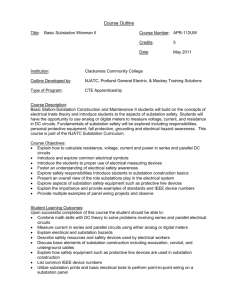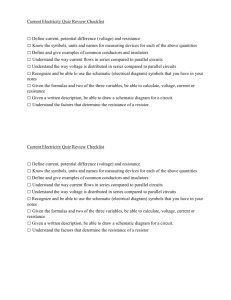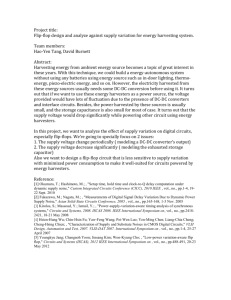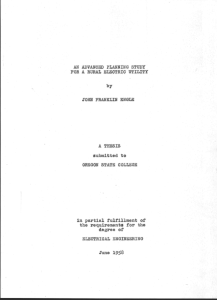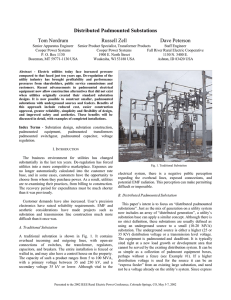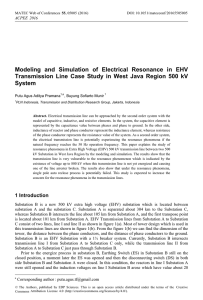Change Course APR 121UW Outline
advertisement
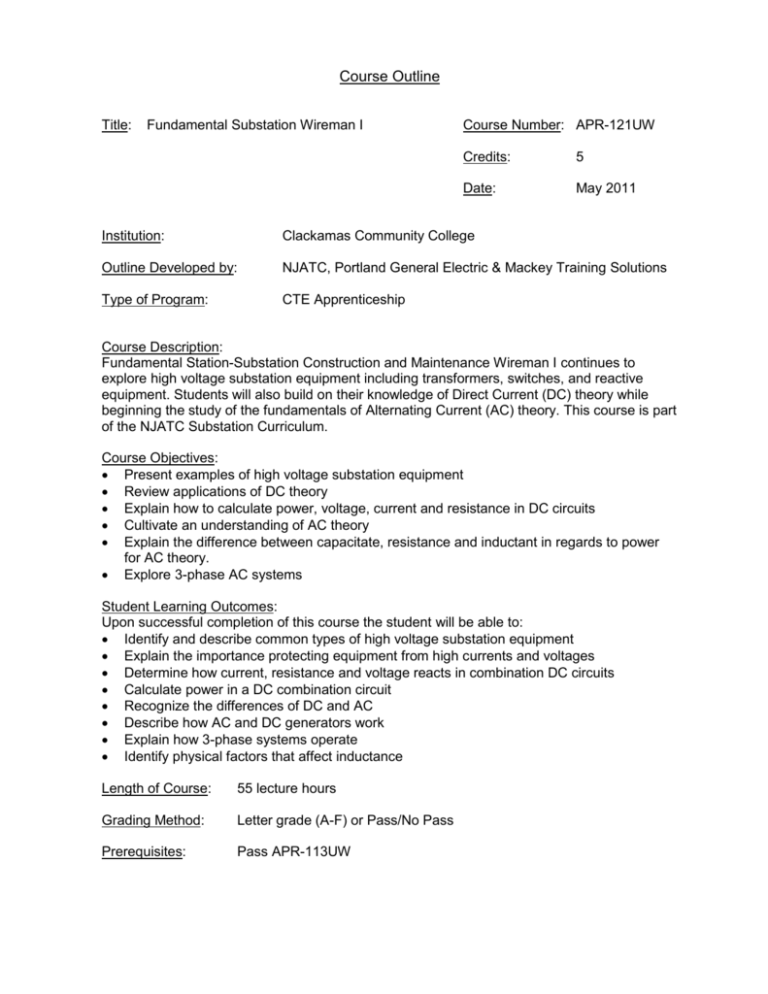
Course Outline Title: Fundamental Substation Wireman I Course Number: APR-121UW Credits: 5 Date: May 2011 Institution: Clackamas Community College Outline Developed by: NJATC, Portland General Electric & Mackey Training Solutions Type of Program: CTE Apprenticeship Course Description: Fundamental Station-Substation Construction and Maintenance Wireman I continues to explore high voltage substation equipment including transformers, switches, and reactive equipment. Students will also build on their knowledge of Direct Current (DC) theory while beginning the study of the fundamentals of Alternating Current (AC) theory. This course is part of the NJATC Substation Curriculum. Course Objectives: Present examples of high voltage substation equipment Review applications of DC theory Explain how to calculate power, voltage, current and resistance in DC circuits Cultivate an understanding of AC theory Explain the difference between capacitate, resistance and inductant in regards to power for AC theory. Explore 3-phase AC systems Student Learning Outcomes: Upon successful completion of this course the student will be able to: Identify and describe common types of high voltage substation equipment Explain the importance protecting equipment from high currents and voltages Determine how current, resistance and voltage reacts in combination DC circuits Calculate power in a DC combination circuit Recognize the differences of DC and AC Describe how AC and DC generators work Explain how 3-phase systems operate Identify physical factors that affect inductance Length of Course: 55 lecture hours Grading Method: Letter grade (A-F) or Pass/No Pass Prerequisites: Pass APR-113UW Major Topic Outline: UNIT 2-3 Substation Equipment Overview Substations – Equipment Power Transformers Substation Switches Voltage Regulators Capacitors Reactors Rectifiers Protective Equipment Lightning Arrestors UNIT 2-4 Reviewing the Applications of DC Theory Understanding Resistance in DC Combination Circuits Current Reacts in Combination Circuits How Voltage Functions in DC Combination Circuits How to Calculate Power in DC Combination Circuits Understanding Resistance in AC Combination Circuits Current Reacts in Combination Circuits How Voltage Functions in AC Combination Circuits How to Calculate Power in AC Combination Circuits Comparing Direct Current to Alternating Current Fundamentals of Alternating Current An Introduction to Three-Phase Systems Understanding How the DC Generator Works Understanding the Design & Function of AC Gen. Voltage Drop CCC AAOT/ASOT GENERAL EDUCATION OUTCOMES COURSE OUTLINE MAPPING CHART APR-121UW Fundamental Substation Wireman I Course Title and Number: Mark outcomes addressed by this course: Mark “C” if this course completely addresses the outcome. Students who successfully complete this course are likely to have attained this learning outcome. Mark “S” if this course substantially addresses the outcome. More than one course is required for the outcome to be completely addressed. Students who successfully complete all of the required courses are likely to have attained this learning outcome. Mark “P” if this course partially addresses the outcome. Students will have been exposed to the outcome as part of the class, but the class is not a primary means for attaining the outcome and assessment for general education purposes may not be necessary. As a result of completing the AAOT /ASOT general education requirements, students will be able to: WR: Writing Outcomes 1. Read actively, think critically, and write purposefully and capably for academic and, in some cases, professional audiences. 2. Locate, evaluate, and ethically utilize information to communicate effectively. 3. Demonstrate appropriate reasoning in response to complex issues. SP: Speech/Oral Communication Outcomes 1. Engage in ethical communication processes that accomplish goals. 2. Respond to the needs of diverse audiences and contexts. 3. Build and manage relationships. MA: Mathematics Outcomes 1. Use appropriate mathematics to solve problems. 2. Recognize which mathematical concepts are applicable to a scenario, apply appropriate mathematics and technology in its analysis, and then accurately interpret, validate, and communicate the results. AL: Arts and Letters Outcomes i 1. Interpret and engage in the Arts & Letters, making use of the creative process to enrich the quality of life. 2. Critically analyze values and ethics within a range of human experience and expression to engage more fully in local and global issues. SS: Social Science Outcomes 1. Apply analytical skills to social phenomena in order to understand human behavior. 2. Apply knowledge and experience to foster personal growth and better appreciate the diverse social world in which we live. SC: Science or Computer Science Outcomes 1. Gather, comprehend, and communicate scientific and technical information in order to explore ideas, models, and solutions and generate further questions. 2. Apply scientific and technical modes of inquiry, individually, and collaboratively, to critically evaluate existing or alternative explanations, solve problems, and make evidence-based decisions in an ethical manner. 3. Assess the strengths and weaknesses of scientific studies and critically examine the influence of scientific and technical knowledge on human society and the environment. CL: Cultural Literacy Outcome ii 1. Identify and analyze complex practices, values, and beliefs and the culturally and historically defined meanings of difference. IL: Information Literacy Outcomesiii 1. Formulate a problem statement. 2. Determine the nature and extent of the information needed to address the problem. 3. Access relevant information effectively and efficiently. 4. Evaluate information and its course critically. 5. Understand many of the economic, legal, and social issues surrounding the use of information. “Arts and Letters” refers to works of art, whether written, crafted, designed, or performed and documents of historical or cultural significance. ii Must be embedded in a course that meets the outcomes for Arts and Letters, Social Science, or Science/Computer Science. iii Must be embedded in the general education required Writing courses. Revised 2010-2011 to reflect Statewide AAOT outcomes i P P P P P P P P P P P P P P P

